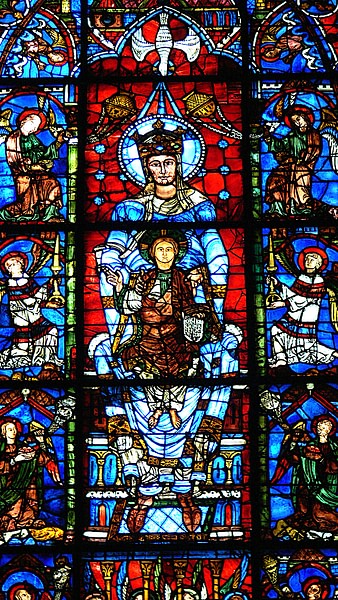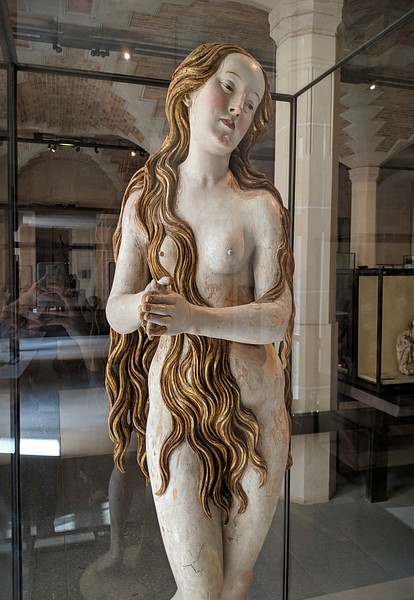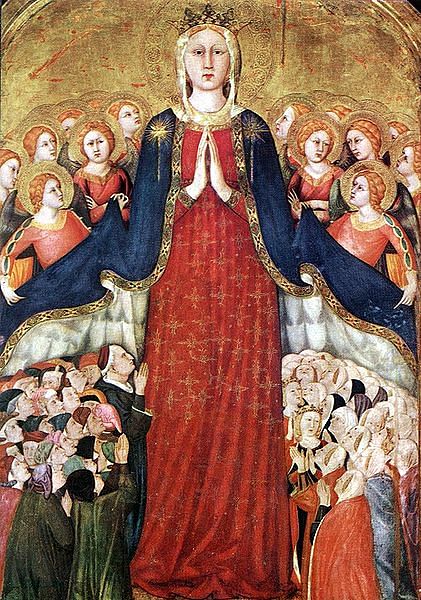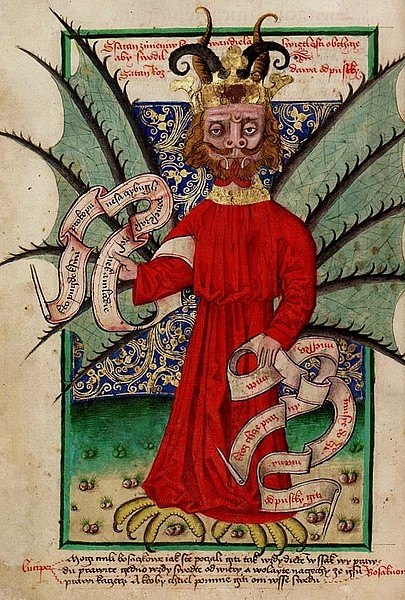How Do You Think Religious Art Was So Important to People in the Middle Ages
Religion in the Middle Ages, though dominated by the Catholic Church, was far more varied than simply orthodox Christianity. In the Early Eye Ages (c. 476-1000 CE), long-established heathen beliefs and practices entwined with those of the new faith so that many people who would take identified as 'Christian' would not have been considered and then by orthodox authority figures.
Practices such every bit fortune-telling, dowsing, making charms, talismans, or spells to ward off danger or bad luck, incantations spoken while sowing crops or weaving cloth, and many other daily observances were condemned by the medieval Church which tried to suppress them. At the same time, heretical sects throughout the Middle Ages offered people an alternative to the Church more in keeping with their folk beliefs.

Blue Virgin Window, Chartres Cathedral
Jewish scholars and merchants contributed to the religious make-up of medieval Europe as well equally those who lived in rural areas who simply were not interested in embracing the new religion and, especially subsequently the Beginning Crusade, Christians and Muslims interacted to each other's mutual do good. As the medieval period progressed, the Church exerted more control over people'southward thoughts and practices, rigidly controlling – or trying to – every aspect of an individual'south life until the rampant corruption of the establishment, besides equally its perceived failure to offering any meaningful response to the Black Death pandemic of 1347-1352 CE, brought on its fracture through the Protestant Reformation of the 16th century CE.
Early Middle Ages & Pagan Christianity
Christianity did not immediately win the hearts and minds of the people of Europe. The process of Christianization was a slow one and, even toward the finish of the Middle Ages, many people still practiced 'folk magic' and held to the beliefs of their ancestors even while observing Christian rites and rituals. The pre-Christian people – now commonly referenced as 'pagans' – had no such label for themselves. The give-and-take 'pagan' is a Christian designation from the French meaning a 'rustic,' one who came from the rural countryside, where the erstwhile beliefs and practices held tightly long subsequently urban centers had more or less adopted orthodox Christian belief.
The conventionalities in fairies, sprites, & ghosts was so deeply embedded that parish priests allowed to go along practices of appeasement.
Even though there is ample evidence of Europeans in the Early Middle Ages accepting the nuts of Christian doctrine, most definitely the existence of hell, a unlike prototype of life on earth and the afterlife was so securely ingrained in the communal consciousness that it could not easily just be set aside. In Britain, Scotland, and Republic of ireland, especially, a conventionalities in the "wee folk", fairies, earth and h2o spirits, was regarded equally simple mutual sense how the world worked. One would no more go out of one's manner to offend a water sprite than poison one'south own well.
The belief in fairies, sprites, and ghosts ('ghosts' divers as spirits of the one time-living) was so deeply embedded that parish priests allowed members of their congregations to continue practices of appeasement even though the Church instructed them to make clear such entities were demonic and not to be trifled with. Rituals involving certain incantations and spells, eating or displaying certain types of vegetables, performing sure acts or wearing a sure type of charm – all pagan practices with a long history – continued to be observed alongside going to Church building, veneration of the saints, Christian prayer, confession, and acts of contrition.
A key concern of the Church, however, was right practice which reflected right belief, and the authorities struggled constantly to bring the population of Europe under their command. The parish or cathedral altar, at which the priest stood to celebrate the mass and transform the bread and vino into the torso and blood of Christ, was far removed from the congregation of onlookers. The priest recited the mass in Latin, his back to the people, and whatever went on up there at the front had little to practice with the people observing information technology.
The baptismal font, therefore, became the focal point of church life as it was present at the offset of i's life (whether physical existence through infant baptism or one'southward spiritual life through baptism equally an adult), at confirmation, weddings, and funerals – even if it was not used at all of these events – and well-nigh notably for the ritual known as the ordeal (or Ordeal by Water) which decided a person's guilt or innocence.

Baptism of Clovis I
The baptismal font was often quite big and deep and the defendant would be bound and thrown into it. If the accused floated to the tiptop, they were guilty of the charges while, if they sank, they were innocent. Unfortunately, the innocent had to enjoy exoneration mail-mortem since they usually drowned. The ordeal was used for serious crimes in a customs too every bit charges of heresy, which included the continued practice of pre-Christian rites.
High Heart Ages & the Cult of Mary
The tendency of the laity to continue these practices did non diminish with time, threats, or repeated drownings. Just every bit in the present day one justifies one's ain deportment while condemning others for the same sort of behavior, the medieval peasant seems to accept accepted that their neighbor, drowned by the Church for some transgression, deserved their fate. There is certainly no tape of public outcry, and the ritual of the ordeal – like executions – were a class of public entertainment.
How the medieval peasant felt about anything at all is unknown as they were illiterate and anything recorded about their beliefs or behavior comes from Church or town records kept by clerics and priests. The peasants' silence is peculiarly noted regarding the Church's view of women, who worked alongside men in the fields, could own their own businesses, join guilds, monastic orders and, in many cases, practice the same piece of work equally a human being but were still considered inferiors. Every bit scholar Eileen Power observes, the peasants of a town "went to their churches on Sundays and listened while preachers told them in i breath that a woman was the gate of hell and that Mary was Queen of Heaven" (11). This view, established by the Church and supported by the aristocracy, would change significantly during the Loftier Middle Ages (1000-1300 CE), even though whatever progress was fabricated would not last.
The Cult of the Virgin Mary was not new to the Loftier Middle Ages – information technology had been popular in Palestine and Egypt from the 1st century CE onward – but became more highly developed during this time. Pope Gregory I (l. 540-604 CE) established the two poles of womanhood in Christianity by characterizing Mary Magdalene as the redeemed prostitute and Mary the Female parent of Jesus as the elevated virgin. Scholars still debate Gregory's reasons for characterizing Mary Magdalene in this style, conflating her with the Woman Taken in Adultery (John 8:1-11), even though there is no biblical support for his merits.

Saint Mary Magdalene
Mary Magdalene, linked through her sins to Eve and the Fall of Man, was the sexual temptress men were encouraged to flee while the Virgin Mary was beyond the realm of temptation, incorruptible, and untouchable. Actual man women might at one time be Magdalene and another the Virgin and, whether one or the other, were best dealt with from a altitude. The Cult of the Virgin, still, at least encouraged greater respect for women.
At the aforementioned time the Cult of the Virgin was developing most apace (or possibly considering of it) a genre of romantic verse and an accompanying platonic was appearing in Southern France, which is known today as courtly love. Courtly honey romanticism maintained that women were non only worthy of respect but adoration, devotion, and service. The genre and attendant behavior information technology inspired are closely linked to the formidable Eleanor of Aquitaine (l. c. 1122-1204 CE), her daughter Marie de Champagne (50. 1145-1198 CE), and writers associated with them such every bit Chretien de Troyes (l. c. 1130-1190 CE), Marie de France (wrote c. 1160-1215 CE), and Andreas Capellanus (twelfth century CE). These writers and the women who inspired and patronized them created an elevated vision of womanhood unprecedented in the medieval period.
These changes occurred at the aforementioned time as the popularity of a heretical religious sect known as the Cathars was winning adherents away from the Catholic Church in precisely the same region of Southern France. The Cathars venerated a goddess of wisdom, Sophia, whom they swore to protect and serve in the same fashion that the noble, chivalric knights in courtly love poetry devoted themselves to a lady. Some scholars (most notably Denis de Rougemont) accept therefore suggested that courtly love poetry was a kind of 'code' of the Cathars, who were regularly threatened and persecuted by the Church, by which they disseminated their teachings. This theory has been challenged repeatedly but never refuted.
The Cathars were destroyed past the Church building in the Albigensian Crusade (1209-1229 CE) with the last blow struck in 1244 CE at the Cathar stronghold of Montsegur. The crusading knights of the Church took the fortress later the Cathars' surrender and burned 200 of their clergy alive as heretics. The Inquisition, led by the order of the Dominicans, rooted out and condemned similar sects.
Islamic & Jewish Influences
The Cathars were non lonely in suffering persecution from the Church, notwithstanding, as the Jewish population of Europe had been experiencing that for centuries. Overall, relations betwixt Jews and Christians were amicable, and there are messages, records, and personal journals extant showing that some Christians sought to convert to Judaism and Jews to Christianity. Scholar Joshua Trachtenberg notes how "in the 10th and eleventh centuries nosotros hear of Jews receiving gifts from Gentile friends on Jewish holidays, of Jews leaving keys to their homes with Christian neighbors before departing on a journey" (160). Relations betwixt members of the two religions were more than or less cordial, in fact, until after the Showtime Cause (1096-1099 CE).
Jewish & Islamic scholasticism contributed more significantly to the culture of Europe than any Christian efforts outside of the monasteries.
Jews were forbidden to bear arms and so could non participate in the crusade, which seems to have upset their Christian neighbors whose husbands and sons were taken by the feudal lords off to the Holy Land. Economical hardships caused by lack of manpower to work the fields further damaged relationships between the two as many Jews were merchants who could go on their trade while the Christian peasant was tied to the land and struggled to constitute, tend, and harvest a ingather.
The Get-go Cause had the reverse effect on Muslims who, outside of Spain, had previously simply appeared in Europe as traders. The cause opened up the possibility of travel to the Holy Land, and a number of scholars took advantage of this to study with their Muslim counterparts. The works of Islamic scholars and scientists found their way to Europe along with translations of some of the greatest classical thinkers and writers such equally Aristotle, whose works would have been lost if not for Muslim scribes. Jewish and Islamic scholasticism, in fact, contributed more significantly to the culture of Europe than any Christian efforts outside of the monasteries due to the xenophobia and airs of the Church building.
The Church building's insistence on the absolute truth of its ain vision, while condemning that of others, extended even to fellow Christians. The Catholic Church building of the West quarreled with the Eastern Orthodox Church in 867 CE over who had the 'true' faith, and the Eastern Orthodox Church finally broke all ties with its western counterpart in 1054 CE, the and then-called Swell Schism. This was brought on by the Church's claim that it was founded by Saint Peter, was the only legitimate expression of Christian organized religion, and should therefore rightly be able to control the Eastern Orthodox Church too every bit its lucrative land holdings.
Late Middle Ages & Reformation
In the Belatedly Heart Ages (1300-1500 CE), the Church connected to root out heresy on the big scale by suppressing upstart religious sects, individually by encouraging priests to punish heterodox belief or practise, and by labeling any critic or reformer a 'heretic' outside of God'southward grace. The peasantry, though nominally orthodox Catholic, continued to observe folk practices and, as scholar Patrick J. Geary notes, "knowledge of Christian belief did not mean that individuals used this knowledge in ways that coincided with officially sanctioned practice" (202). Since a medieval peasant was taught the prayers of the Our Begetter and Hail Mary in Latin, a linguistic communication they did not understand, they recited them as incantations to ward off misfortune or bring luck, paying little attention to the importance of the words equally understood by the Church building. The mass itself, also conducted in Latin, was equally mysterious to the peasantry.

Madonna of Mercy, Orvieto
Consequently, the medieval peasant felt far more comfortable with a blending of the old pagan beliefs with Christianity which resulted in heterodox conventionalities. Parish priests were again instructed to take heretical practices seriously and punish them, merely the clergy was disinclined, largely considering of the effort involved. Further, the majority of the clergy, peculiarly the parish priests, were corrupt and ineffective and had been and then for quite some time. One of the reasons heretical sects attracted adherents, in fact, was the respect generated by their clergy who lived their beliefs. In dissimilarity, every bit Geary notes, the Catholic clergy epitomized the very Seven Deadly Sins they condemned:
The ignorance, sexual promiscuity, venality, and corruption of the clergy, combined with their frequent absenteeism, were major and long-standing complaints within the laity. Anti-clericalism was endemic to medieval order and in no way detracted from religious devotion. (199)
A parishioner could loathe the priest just still respect the religion that said priest represented. The priest, after all, had little to do with the life of the peasant while the saints could answer prayers, protect one from damage, and reward one's adept deeds. Pilgrimages to saints' sites like Canterbury or Santiago de Compostela were thought to please the saint who would and then grant the pilgrim favors and expiate sin in ways no priest could ever do.
At the same fourth dimension, one could not do without the clergy owing to the Church building's insistence on sacerdotalism – the policy which mandated that laypersons required the intercession of a priest to communicate with God or understand scripture – and so priests still wielded considerable power over individuals' lives. This was particularly and then regarding the afterlife state of purgatory in which i's soul would pay in torment for any sins non forgiven by a priest in one's life. Ecclesiastical writs known as indulgences were sold to people – oft for high prices – which were believed to lessen the time for one's soul, or that of a loved one, in purgatorial fires.

The Devil Selling Indulgences
The unending struggle to bring the peasantry in line with orthodoxy somewhen relented equally practices formerly condemned past the Church building – such equally astrology, oneirology (the written report of dreams), demonology, and the apply of talismans and charms – were recognized as pregnant sources of income. Sales of relics similar a saint'due south toe or a splinter of the True Cross were common and, for a cost, a priest could interpret one's dreams, chart 1'southward stars, or name whatsoever demon was preventing a good union for one's son or daughter.
For many years, medieval scholarship insisted on a dichotomy of two Christianities in the Middle Ages – an elite culture dominated by the clergy, city-dwellers, and the written discussion, and a popular culture of the oral tradition of the rural masses, infused with pagan belief and practise. In the present day, it is recognized that pagan beliefs and rituals informed Christianity in both city and land from the showtime. Every bit the Church building gained more and more power, it was able to insist more stridently on people obeying its strictures, but the same underlying grade – of the Church building trying to impose a new belief structure on people used to the one of their ancestors – remained more or less intact throughout the Centre Ages.
Decision
As the medieval period wound to a shut, the orthodoxy of the Church finally did permeate downward through the lowest social class merely this hardly did anyone any favors. The backlash against the progressive movement of the twelfth century CE and its new value of women took the form of monastic religious orders such as the Premonstratensians banning women, guilds which had previously had female members declaring themselves men'southward-only-clubs, and women'southward ability to run businesses curtailed.
The ongoing crusades vilified Muslims as the archenemy of Christendom while Jews were blamed for practicing usury (charging involvement) – even though the Church had more or less defined that function in finance for them through official policy – and were expelled from communities and unabridged countries. Pagan practices had now either been stamped out or Christianized, and the Church building held meaning ability over people'due south daily lives.
The far-reaching corruption of the medieval Church, however, against which critics and reformers had been preaching for centuries, finally grew besides intolerable and general distrust of the Church and its vision was further encouraged past its failure to see the claiming of the Blackness Death pandemic of 1347-1352 CE which resulted in a widespread spiritual crunch. The Protestant Reformation began equally only another endeavor at getting the Church to pay attending to its own abuses and failings, just the political climate in Germany, and the personal ability of the priest-monk Martin Luther (fifty. 1483-1546 CE), led to a revolt past people who had long grown tired of the oppressive bullying of the monolithic Church building.
Afterwards Martin Luther initiated the Reformation, other clerics in other regions followed his example. Christianity in Europe afterwards would oft evidence itself no more tolerant or pure in protestant course than it had been as expressed through the medieval Church but, in time, found a way to coexist with other faiths and permit for greater freedom of individual religious feel.
This article has been reviewed for accuracy, reliability and adherence to academic standards prior to publication.

0 Response to "How Do You Think Religious Art Was So Important to People in the Middle Ages"
Post a Comment